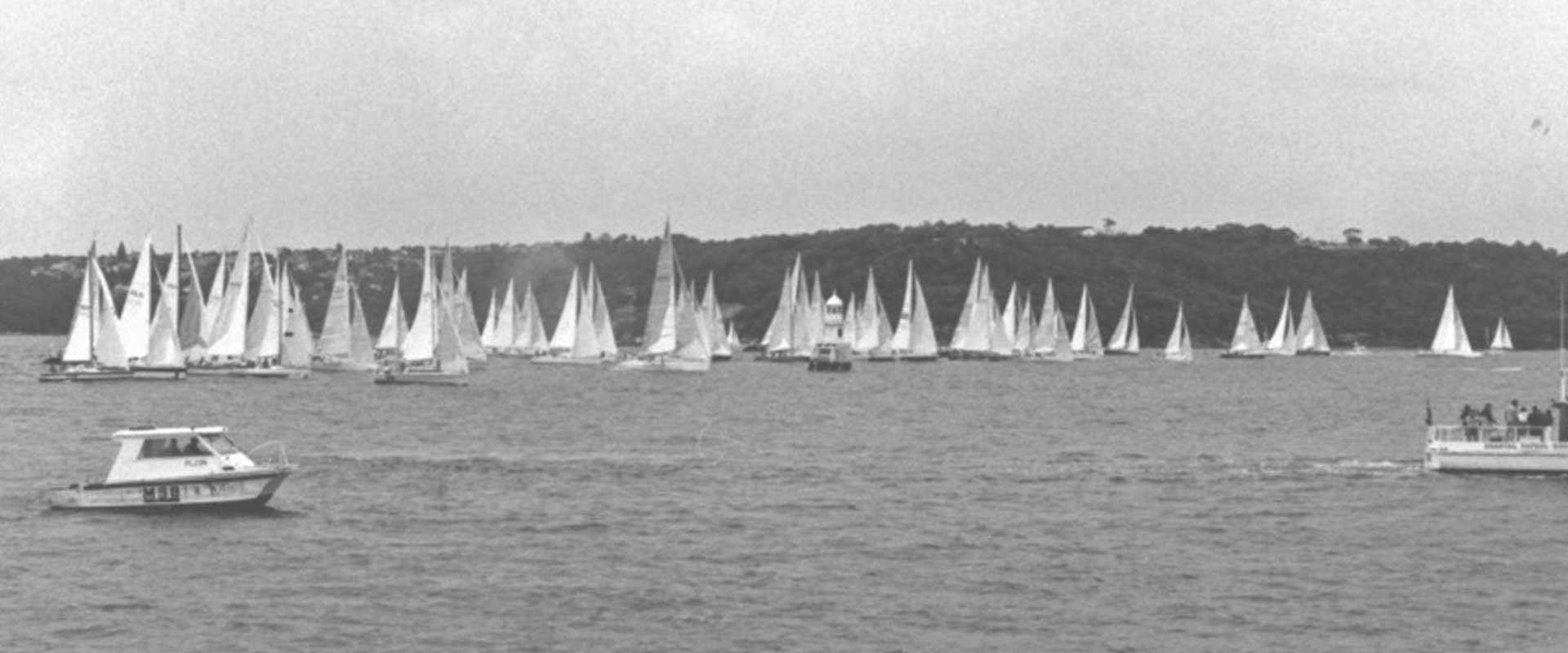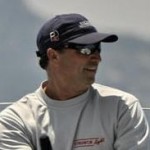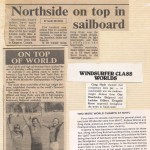| Robert Wilmot | |
|---|---|
 Bobbie Windsurfing | |
| Other Name | Rob, Robbie |
| Gender | Male |
| Nationality | Australian |
| Hometown | Sydney |
| Club | Middle Harbour Yacht Club |
| Facebook Page | bob.wilmot.3 |
| Boats Sailed On | Brindabella Ragamuffin Transfusion |
Robert Wilmot
Bobby first took out his own Manly Junior aged 5. He won a State Championship at 8, in the Flying Ant class, beating 15-year olds. He won every National Windsurfer Championship from 1977 to 1984, including six World Championships and a Bronze Medal at the Los Angeles Olympics.
In the 1988 Olympics he skippered the Soling crew. His successes in major world match racing regattas were great preparation for joining the America's Cup defence syndicate in 1987. Bobby steered Ragamuffin to her Sydney to Hobart line honours victory in 1984, and Brindabella to her line honours win in 1997, but was happy just to finish in 1998's storm-tossed race as co-helmsman of Brindabella.
About |
1983 | 1983 Windsurfer Worlds in Kingston, CanadaNorthsider board-sailors have again shown their world-beating form by winning three of the four weight division world titles at the recent Windsurfer Class world series held in Kingston, Canada. Five hundred 'competitors from 25 countries contested the event in four disciplines - triangle racing, marathon, slalom and freestyle. In the triangle racing, Greg Hyde won the medium weight division, Robert Wilmot the light heavyweight, and Tom Luedecke the heavyweight. Another northsider, Stuart Gilbert, was runner up to US board sailor, Scott Steele, in the lightweight division. |
1984 | National Champion of Light Heavyweights Division in WindsurfersFrom Australia's Year of Sails edited by Sandy Peacock The 1983 Windsurfer Class nationals were held over Christmas/New Year at Mooloolaba in Queensland. Each year they are the biggest yachting event in the country, and l 983 set a new record with 272 competitors. Our Olympic representative Greg Hyde won the lightweight division, Lachlan Gilbert the mediumweights, . while Bobby Wilmot, the runner up at the Olympic trials and Olympic Boardsailing Exhibition (O.B.E.) event team member, won the light heavyweights. Phil McGain won the heavyweights. Melanie Braund won the ladies division and, with her runners-up Sarah Kenny and Bruce Wylie, they make up the Australian team for the O.B.E. event at the Olympics. Since being selected in Adelaide for the Olympics Greg Hyde has been competing in Europe. He has won every major event that he has entered and defeated the top seed Stephan Van Den Berg. Greg was one of the first sailors to buy a sailboard when the sport was introduced to Australia in 1977. He has always been one of the top if not the top flat-water racer in the country. Right through that time he has continued his full-time study and even made some more time for a few skiff and yacht titles. Even with the ever-expanding meaning that seems to be given to "amateur" Greg still fits into the real meaning. A look at the OlympicsSource: Freestyle
The choice of the Windglider as the Olympic sailboard was received by most to be if not a bad decision, certainly a political one. But now that the event looms closer the Windglider is becoming generally regarded as suited to its role -if nothing else. By virtue of the Windglider's larger volume and sail area it is not so sensitive to a sailor's weight. This is an advantage in the Olympics as there is only provision for one medal (no weight group racing and no medal for the demonstration event). For whatever reason, the Olympic Committee have again followed the Windglider's class rules and have not allowed competitors' to use harnesses. Looking at the board itself, it seems quite ordinary if you were not to notice the 'Chevoleat' styling of the tail area. Nevertheless, for those training for the selections the only concern is their ability to adapt to the board and to sail it without a harness. When sailing the board, its lack of maneuverability stands out. The rails are so thick and straight that turning is very difficult. Understandably, gybing (especially with the centreboard down) is an acquired art. The whole situation is not helped by a very inadequate anti-skid. The standard rig has been highly criticised. The masts are quite easily broken and the Dacron sail is badly cut. The front boom fitting is unable to provide a tight fit to the mast and the boom is badly shaped (having its maximum width in the middle). But for the Olympics there is a special rig. Although the standard boom remains, there is a Mylar sail and an aluminium mast. With these improvements on the sail area the same as for Open Class, the rig is very good even in the company of other Open Class sailboards. Although any board has to be sailed in its own way, this is particularly so in the case of the Windglider. All your movements have to be accentuated - the rig movements increased, the rail pushed harder, and your body more contorted. The contenders for Olympic selection have been competing in the Windglider National Championships and Olympic Selection Trials. On the basis of their performance in the trials and past performances, the Australian Olympic Selection Committee will make their decision. Two leading contenders are Bobby Wilmot and Greg Hyde. Both have been sailboarding since the sport began in Australia. The current titles Bobby holds are: Australian National Windsurfer Class Champion (medium heavies); Wind-surfer Class World Champion (medium heavies); Dufour Wing World Champion (heavies); Overall Winner Mistral World Championships; Yacht Match Racing Series Champion (conducted on J-24s); second place overall in the Pan Am Clipper Cup (skipper Szechwan). Greg Hyde is the present Windsurfer Class World Champion (mediums) as well as National Champion (lightweights and penthathlon). |














